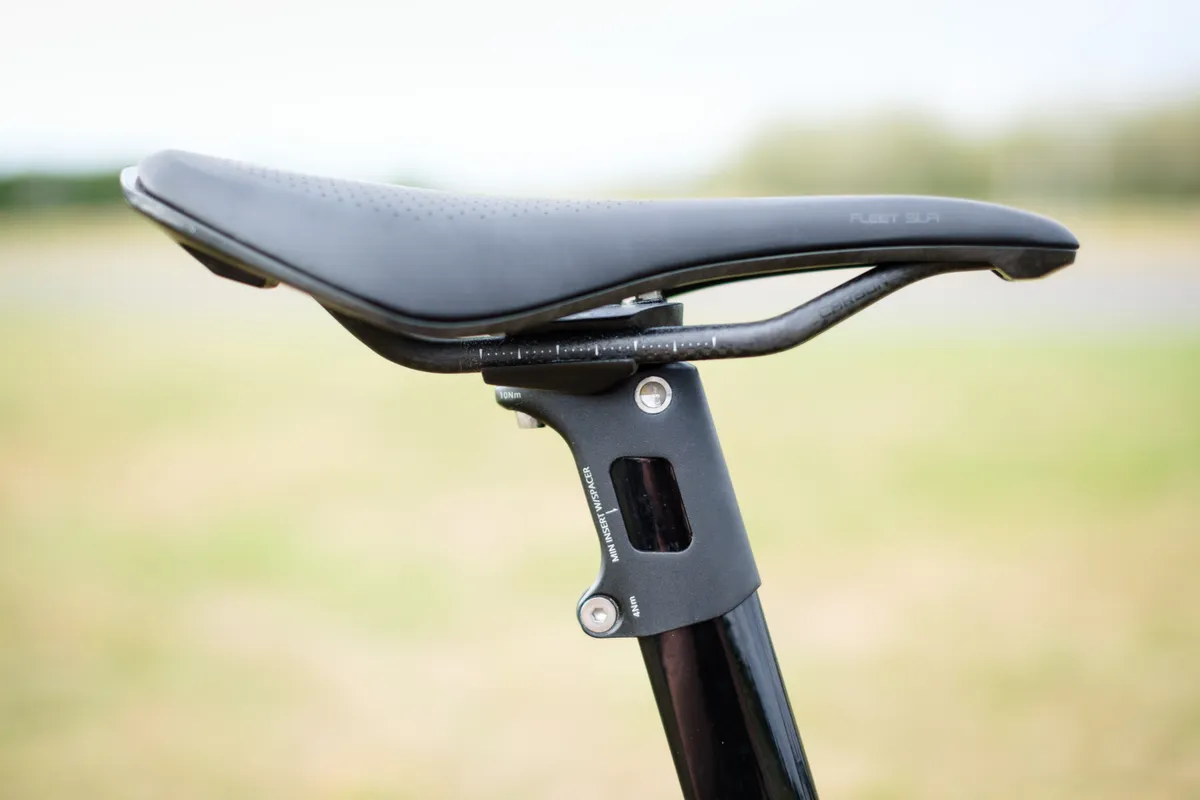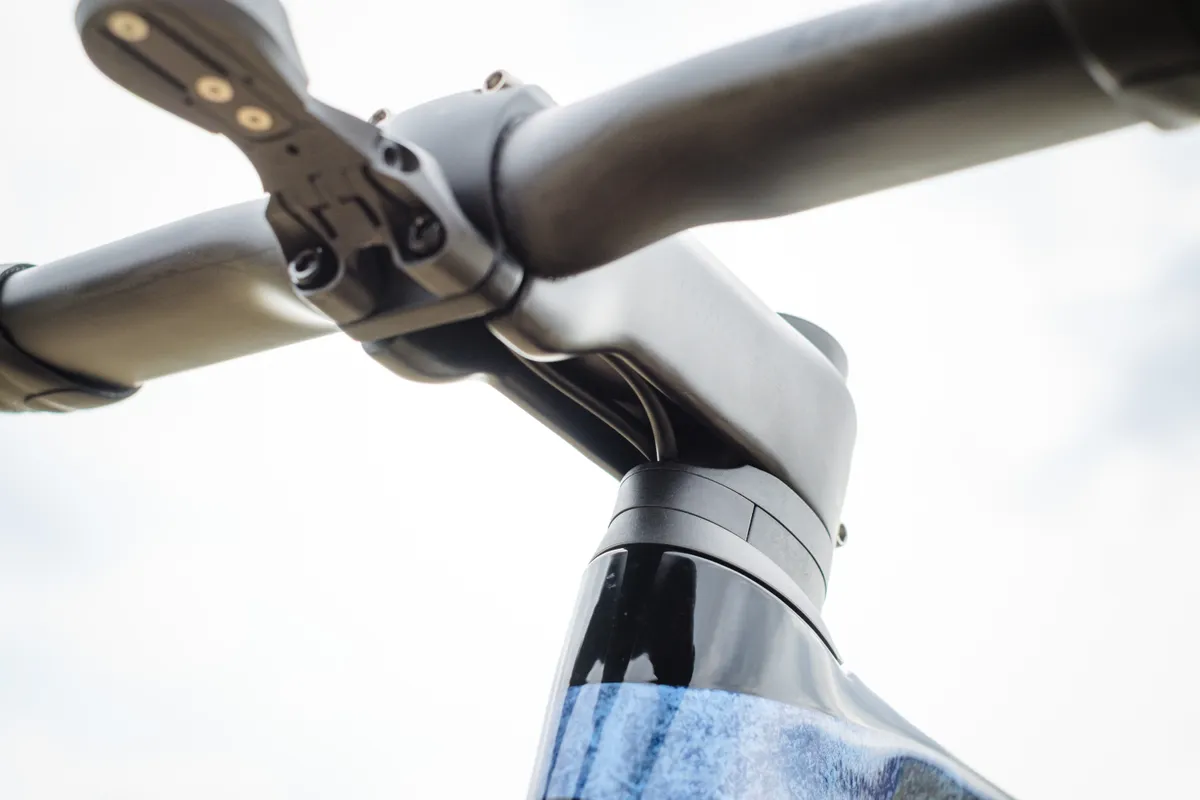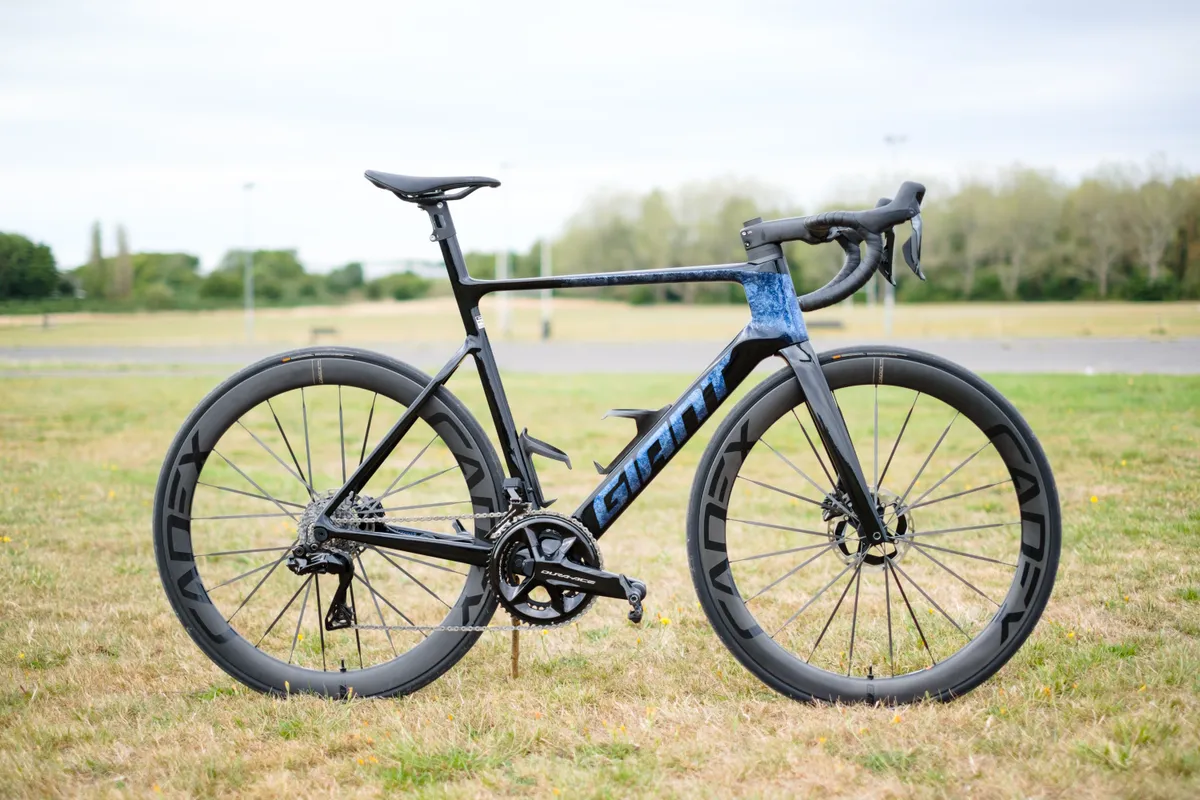The Giant Propel Advanced SL 0 is the latest flagship aero road bike from the Taiwanese behemoth.
While the previous Propel (which launched in 2018) went all in on aerodynamic efficiency at the expense of some added weight, this latest version is intended to offer the best of both worlds.
With an exceptionally low weight of just 6.91kg, the Propel is competitive on the scales with some of the best climbing bikes, yet appears to sacrifice little in terms of outright speed on the flats.
On top of this, smart refinements such as an increase in tyre clearance, an overhauled cable routing system and a new two-piece aero cockpit, make the new Propel a bike that isn’t overly specialised or difficult to live with.
While at £11,999 / $12,500 / €12,000 / AU$13,999 the price of this WorldTour spec race bike is predictably lofty, the Propel Advanced SL 0 is a true do-it-all road bike with few compromises.
Giant Propel Advanced SL frameset
Unusually for a self-styled aero road bike, the headline feature on the new Propel frameset is its low weight.
At a claimed 1,429.5g for a size medium frameset, the 2023 Propel is only 163.5g heavier than the latest Giant TCR Advanced SL frameset – an almost imperceptible difference.
It’s clear Giant isn’t lying about this either. Our size ML test bike weighs a feathery 6.91kg, including the new aero bottle cages and an out-front computer mount.
There are relatively few competitors in the aero road bike space that can come close to matching that weight figure (bikes such as the Specialized S-Works Tarmac SL7, Factor Ostro VAM and Canyon Aeroad CFR spring to mind).

Of course, the new Propel likely gives up some aerodynamic efficiency compared to heavier, more aggressively aero-optimised bikes such as the Cervélo S5, Cannondale SystemSix, Orbea Orca Aero or Trek Madone SLR.
But given the balance of comments we receive on the subject, the compromise struck by the Propel is likely closer to what most people want from a high-performance road bike.
Nevertheless, Giant claims the aerodynamic performance of the latest Propel surpasess that of the previous version as a complete bike by 6.21 watts at 40kph, equating to 27 seconds over 40km.
Notably, though, this figure includes the new Contact SLR Aero cockpit, Cadex 50 Ultra Disc wheelsystem and Cadex Aero Tubeless tyres (more on these later).
How much of that 6.21 watts improvement is attributable to the various component parts is unclear, but if you’re buying it as a complete bike, it arguably doesn’t matter.

My only quibble with the Propel Advanced SL frameset concerns the integrated seatpost.
The flippable head that allows you to switch between -5 and +15mm of offset is great (although this is also a feature on the non-integrated Giant Variant Advanced seatposts), but I think the negatives of the integrated design outweigh the positives.
It looks cool and may offer a small improvement to weight and compliance, but having to permanently cut a frame down to size simply to set your saddle height feels a little extreme – especially if you’ve never had a professional bike fit and don’t know if your current setup is ideal.
Once cut, your saddle height can be adjusted back up a few centimetres using spacers (two seatpost toppers are included with the bike, which allow you to run up to 20 or 45mm of spacers each), but there’s a permanent ceiling on how high you can now go.

Likewise, changing to cycling shoes or road bike pedals with a marginally lower stack height might require further cutting of the seatpost.
It can also make travelling or flying with your bike tricky, because there’s no way to remove the seatpost to fit the frame inside a bike box or bike bag.
Lastly, if you ever consider selling the frameset, prospective buyers will need to have either a similar or lower saddle height (likely hurting its resale value).
Once set up and ready to ride, it’s not not a day-to-day issue, but standard telescoping seatposts weren’t – for the most part – a problem that needed solving.

Giant Propel Advanced SL 0 geometry and ride feel
Out on the road, the Propel Advanced SL 0 is an impressive machine.
On flat or rolling roads and descents, it doesn’t quite feel as rapid as the fastest aero road bikes I’ve tested, such as the Cervélo S5 or Cannondale SystemSix, but it runs rings around those bikes on the scales.
I’ve said many times that weight doesn’t matter much for aero road bikes, but usually we’re only talking about a few hundred grams here or there.
In this case, the Propel is around a kilogram lighter than those bikes, and that is something that can affect performance on long or steep climbs.
How much this matters depends on where you ride, but if you’re someone who likes to attack climbs as well as everything in between, then the Propel is a perfect match.

With its relatively small frame tubes, it’s also little trouble on windy days, making it an accessible ride.
Super-deep frame tubes and wheel rims can be very fast in favourable conditions, but, as noted in Ashley Quinlan’s review of the latest Trek Madone SLR 9 eTap, they can also make a bike more sensitive in crosswinds.
The modification of the geometry to mirror that of the TCR is also welcome. It’s a tried and tested formula that makes the Propel feel nimble and responsive, without ever tipping into feeling unpredictable.
| Frame size | XS | S | M | ML | L | XL |
|---|---|---|---|---|---|---|
| Seat tube length (mm) | 680 | 710 | 740 | 770 | 800 | 830 |
| Seat tube angle (degrees) | 74.5 | 74 | 73.5 | 73 | 73 | 72.5 |
| Top tube length (mm) | 520 | 535 | 550 | 565 | 580 | 600 |
| Head tube length (mm) | 120 | 130 | 145 | 165 | 185 | 200 |
| Head tube angle (degrees) | 71 | 72.25 | 73 | 73 | 73 | 73 |
| Fork rake (mm) | 45 | 45 | 45 | 45 | 45 | 45 |
| Trail (mm) | 71 | 63 | 58 | 58 | 58 | 58 |
| Wheelbase (mm) | 976 | 976.6 | 980 | 991 | 1,006 | 1,020 |
| Chainstay length (mm) | 405 | 405 | 405 | 405 | 405 | 405 |
| Bottom bracket drop (mm) | 72 | 69.5 | 69.5 | 67 | 67 | 67 |
| Stack (mm) | 517 | 528 | 545 | 562 | 581 | 596 |
| Reach (mm) | 376 | 383 | 388 | 393 | 402 | 412 |
| Stand over height (mm) | 722 | 753 | 770 | 794 | 821 | 834 |
| Handlebar width (mm) | 400 | 400 | 420 | 420 | 440 | 440 |
| Stem length (mm) | 80 | 90 | 100 | 110 | 110 | 120 |
| Crank length (mm) | 170 | 170 | 172.5 | 172.5 | 175 | 175 |
Despite its 700 x 25c tyres (which measure 27.3mm wide when inflated to 75 PSI / 5.2 BAR) and impressive pedalling stiffness, I found it to be a surprisingly comfortable ride for a pure race bike, too.
The slim rear end and carbon handlebar do a great job of dissipating road buzz and preventing too much build-up of fatigue from riding on rough roads.
Frame and fork clearance has also been increased to accommodate tyres up to 30mm (measured width when inflated), meaning you can go slightly wider than stock if desired.

Giant Propel Advanced SL 0 finishing kit
All things considered, the Propel Advanced SL 0’s finishing kit is excellent, apart from one niggly detail.
It’s somewhat surprising the lighter, more premium Cadex Boost saddle isn’t present on this top-spec build, but I found the included Giant Fleet SLR saddle to be extremely comfortable from the first ride. I have no complaints about it from a performance perspective (I have the cheaper Fleet SL saddle on my own Giant TCR Advanced Pro 2 Disc, which is identical save for its alloy, rather than carbon, rails).

Likewise, I think the new Contact SLR Aero cockpit and OverDrive Aero cable routing system strike a great balance between performance and practicality.
For a start, the new cable routing system – which sees gear cables (if present) and hydraulic brake hoses run internally through the handlebar and then under the stem and into the frame through the upper headset bearing – lends the new Propel a much cleaner look than before.

The new Contact SLR Aero carbon stem also has a round, 31.8mm handlebar clamp, meaning you have plenty of options in terms of handlebar choice if you don’t like the stock setup.
That’s important because while the stock Contact SLR Aero carbon handlebar is great, it’s only available in widths from 400mm to 440mm. Sadly, there are no options for fans of narrow handlebars, such as myself.

As the new Propel uses a D-shaped steerer (in order to make room for the new cable routing path), the Contact SLR Aero stem is the sole stem option for the new Propel.
As far as stems go, though, it’s also a relatively understated piece of kit that looks good, feels plenty stiff and generally goes about its job without any fuss.

It’s only available in a single, -10 degree angle (it can’t be flipped to offer a +10 degree rise because of how the new cable routing system works), but given it comes in a range of sizes from 70 to 130mm, most riders should be able to tune their riding position without too much trouble.

The subtly aero-optimised composite bottle cages are a nice touch, too.
They’re similar to those seen on the BMC Teammachine SLR, and though Giant doesn’t offer any data as to what sort of performance gain they might offer, they look great and integrate with the bike very nicely.

Giant also includes a highly adjustable, out-front bike computer mount, which is handy to have (even if it’s not as pretty as the alloy Fouriers ones we saw on Team BikeExchange-Jayco pro bikes at this year’s Tour de France).

Giant Propel Advanced SL 0 groupset wheels and tyres
Shimano Dura-Ace Di2 R9270 groupset
While a full review of Shimano’s latest flagship groupset, Dura-Ace Di2 R9200 is in the works, numerous testers here at BikeRadar have accrued many hundreds (if not thousands) of kilometres on it now, and can confidently attest that it offers near-faultless all-round performance.
It’s one of the lightest road bike groupsets available, and shifts are fast and crisp at both ends. The updated lever hood ergonomics and wider standard gearing ranges compared to the previous generation are also clear improvements.

Switching between the Propel and my Giant TCR Advanced Pro 2 Disc, which is equipped with a Shimano 105 R7020 groupset, it’s also obvious how much quieter the new generation of 12-speed Shimano groupsets are in terms of drivetrain noise.
The updated hydraulic disc brakes also rub less often than the previous ones.
The only major downside is that it adds a premium to the bike’s price compared to the likes of Ultegra Di2 R8170 or SRAM Force eTap AXS, for little gain in performance beyond weight savings.

Still, if you want one of the lightest, shiniest and best-performing groupsets available, Dura-Ace Di2 R9200 is certainly up there.
It’s also great that Giant includes the latest Shimano Dura-Ace power meter crankset as standard.
The FC-R9200P is a native, dual-sided power meter, and while I’ve not used it enough to make a definitive judgement, my initial impressions of the data accuracy compared to a set of Favero Assioma Duo power meter pedals is encouraging.
Cadex 50 Ultra Disc wheelsystem and Cadex Aero Tubeless tyres

A big part of the new Propel Advanced SL 0’s impressively low weight is down to the Cadex 50 Ultra Disc wheelset, which has a claimed weight of just 1,349g.
That’s very light, especially when you factor in the 50mm-deep, aerodynamically optimised hookless rims.
Usefully, Cadex has made these rims significantly wider (both internally and externally) than on previous wheelsets, such as the Cadex 42 Disc wheelset.
With a maximum external rim width of 30mm and an internal width of 22.4mm, the new 50 Ultra rims should offer improved aerodynamic performance with larger tyres that have an inflated width in the region of 28mm.

These rims are coupled with lightweight, carbon aero spokes as well as aerodynamically optimised Cadex hubs, which are fitted with ceramic bearings.
There isn’t a night and day difference in performance between this wheelset and more value-focused options such as Hunt’s 54 Aerodynamicist Carbon Disc, but it’s a wheelset that leaves very little to be desired and excels in almost every area.
The new Cadex Aero Tubeless tyres offer an interesting take on high-performance tyres, with a casing shape and tread that are claimed to be aerodynamically optimised.
Its taller, more ovalised form results in a noticeably slimmer contact patch compared to the shorter, rounder and broader one seen on most of the best tubeless road tyres, and I was initially concerned this would dent my cornering confidence.
Happily, that didn’t appear to be the case: I didn’t notice any clear difference in handling.

My only reservation is that Cadex tyres have historically not performed well in independent rolling resistance tests, so the jury is still out on that.
On the road, the tyres feel supple and grippy, and I’ve no obvious sensation of high rolling resistance to report.
Cadex says the Aero Tubeless tyre uses a new tread compound, which offers a 15 per reduction in rolling resistance compared to its Race Tubeless TLR. If true, that would go some way in helping it compete with benchmark tyres such as the Continental GP5000S TR or Schwalbe Pro One TLE.

For the poor-quality roads around south Bristol, and across the UK in general, I’d also prefer the increased volume and grip of 700 x 28c tyres.
Curiously, though, this isn’t a size the Cadex Aero Tubeless tyre is offered in, which feels somewhat out of step with the direction of travel for the industry as a whole.
Still, swapping to a different set of tyres is one of the easiest and cheapest ways to upgrade your bike, so it’s not a deal breaker.
Giant Propel Advanced SL 0 bottom line

The Giant Propel Advanced SL 0 might not be the most visually exciting bike, nor the outright lightest or fastest road bike available, but it is exceptionally competitive in practically all areas.
It’s vanilla, but in the best possible way.
A more aerodynamically extreme bike will almost certainly come with weight or adjustability penalties, while a lighter one would likely be less aerodynamic, and while having multiple bikes to optimise for every possible riding situation may be an option for some professional riders, it’s unrealistic for most people.
The only catch is that getting this featherweight spec requires a significant financial investment, but that’s the case with every bike namechecked here. There are also plenty of equivalently specced competitors that cost more.
The new Propel is such a good all-rounder, though, it does beg the question; what now for the TCR?
Product
| Brand | giant |
| Price | 13999.00 AUD,12000.00 EUR,11999.00 GBP,12500.00 USD |
| Weight | 6.9100, KILOGRAM (ML) - With bottle cages and included out-front computer mount |
Features
| Fork | Advanced SL-grade composite |
| br_stem | Giant Contact SLR Aero |
| br_chain | Shimano Dura-Ace 12-speed |
| br_frame | Advanced SL-grade composite |
| Tyres | Cadex Aero Tubeless, 700x25c |
| br_brakes | Shimano Dura-Ace R9270 |
| br_cranks | Shimano Dura-Ace FC-R9200-P power meter crankset, 52-36t |
| br_saddle | Giant Fleet SLR |
| br_wheels | Cadex Ultra 50 Wheelsystem |
| br_headset | Giant OD2 Road |
| br_shifter | Shimano Dura-Ace R9270 Di2 |
| br_cassette | Shimano Dura-Ace R9200, 11-30t |
| br_seatpost | Integrated |
| br_gripsTape | Stratus Lite 2.0 |
| br_handlebar | Giant Contact SLR Aero |
| br_bottomBracket | BB86 |
| br_availableSizes | XS, S, M, ML, XL |
| br_rearDerailleur | Shimano Dura-Ace R9250 Di2 |
| br_frontDerailleur | Shimano Dura-Ace R9250 Di2 |

